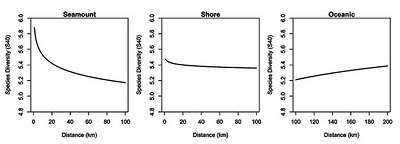Monday
May102010
Mountains of Pelagic Diversity
 Monday, May 10, 2010 at 9:00AM
Monday, May 10, 2010 at 9:00AM If you ever saw the dramatic seamount scene in Blue Planet (and if you haven’t, where ya been??), then you are probably familiar with the idea that submarine mountains can attract lots of animals; as Attenborough puts it, they “create oases where life can flourish in the comparatively empty expanses of the open ocean”. In that spectacular BBC sequence, jacks and tuna swarm an Eastern Pacific seamount peppered with colourful schools of barberfish, Anthias and goatfish. Then the sharks cruise in, including silkys and hammerheads, there for a clean from the faithful barberfish.
There’s a paper in the latest issue of PNAS that quantifies the richness of seamounts, so beautifully depicted by those geniuses at the BBC Documentary department. The authors, led by Telmo Morato from the Secretariat of the Pacific Community in New Caledonia, analysed data gathered by longline fisheries in the western and central Pacific, close to and remote from seamounts . In a sense, a longline is a standardized sort of sampling unit like a quadrat, so they can be analysed across locations to measure differences in diversity. They accounted for differences between total catch per longline using the statistical process called rarefaction which is a practical application of one of my favourite fundamental biological patterns – the species accumulation curve - which I’ve discussed before (here and here). It looks like a great dataset with great spatial resolution and pretty good coverage in the tropics, though the equatorial zones are less well-represented.
I don’t think anyone would be surprised by their result that, yes, seamounts are diverse places. When they broke it down by species, about 2/5 (15 species) showed positive association with seamounts; this group included both sharks and fish. Interestingly, 3 species (pelagic stingrays, albacore and shortbilled spearfish) showed negative associations with seamounts, while 19 showed no measurable association. So, the net effect is positive, but there's clearly some structure in the data, depending on what species you look at. Nor, I think , would most people be surprised by the distance effect they found, wherein sample diversity decreased with distance moved away from the peak of a seamount, and most sharply in the first 10 or so kilometers. What was surprising, to me at least, was that both the absolute diversity and the distance effect they found were greater on seamounts (left) than they were for coastal zones (center).
I would have thought that coastal zones, with their larger area, more complex topography and currents, coastal upwelling and inputs from the land, should have had higher diversity. Indeed, it kind of goes against the island biogeography ideas, that as we go away from the largest habitat towards smaller more distant patches, diversity drops; if you think of seamounts as underwater islands and continental shelves as underwater mainlands, perhaps you’ll see what I mean.
There’s a couple of reasons I can think of to explain the observed difference. Perhaps there is something intrinsic to seamounts, some feature of topography or productivity that makes them real magnets for diversity. Under this scenario, they are true biodiversity hotspots. Alternatively, perhaps coastal zones once were more diverse than seamounts but have been denuded by our actions, so that only the remote and submarine mountains remain as examples of what once was. Perhaps it’s a bit of both, or some other concept (that you should propose in the comments). Either way, Morato et al. show us that we may be successful at protecting widely roaming pelagic species by strategically preserving relatively tiny specks of submarine oases. Since reading their paper, I have enjoyed thinking of schools of pelagics, hopping from mountaintop to mountaintop, skipping across vast plains of abyssal ocean, and as usual dreaming about diversity and all the fantastic forms of life in the 3D wonderland of the open ocean. It just makes you want to down tools and grab the next slow boat bound for Cocos, doesn't it?
Morato, T., Hoyle, S., Allain, V., & Nicol, S. (2010). Seamounts are hotspots of pelagic biodiversity in the open ocean Proceedings of the National Academy of Sciences DOI: 10.1073/pnas.0910290107



Reader Comments (3)
Hi Alistair
I am one of the co-authors of this paper on seamounts and I really like the way you tell the story. Our communication/information section would like to print your article in one of our newsletter. Is that OK?
Cheers
Valerie
No problem! Just puttheblog address if you would. Thanks!
Al
Excellent. We will definitely cite the source wit he blog address
Thanks. Valerie